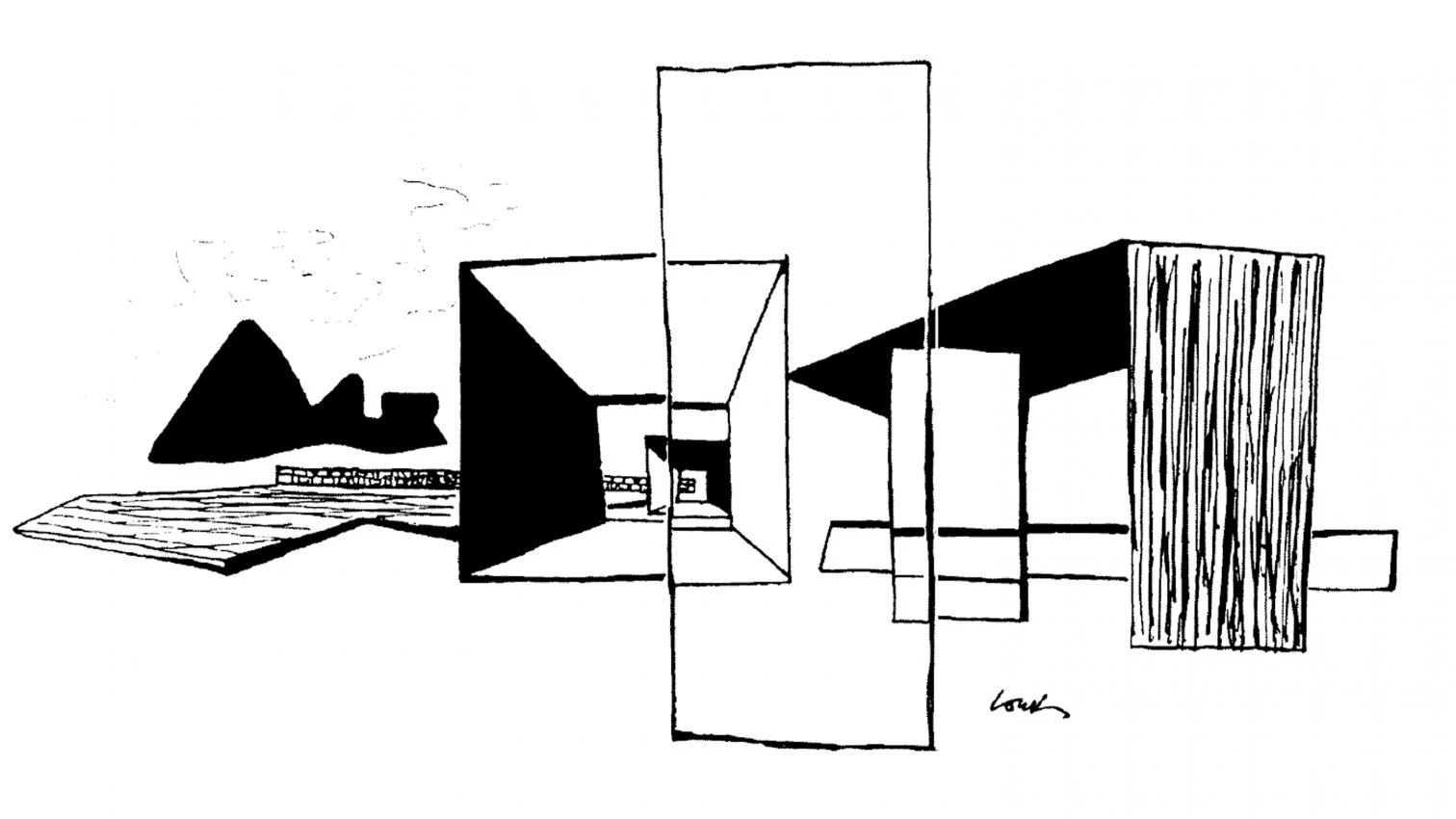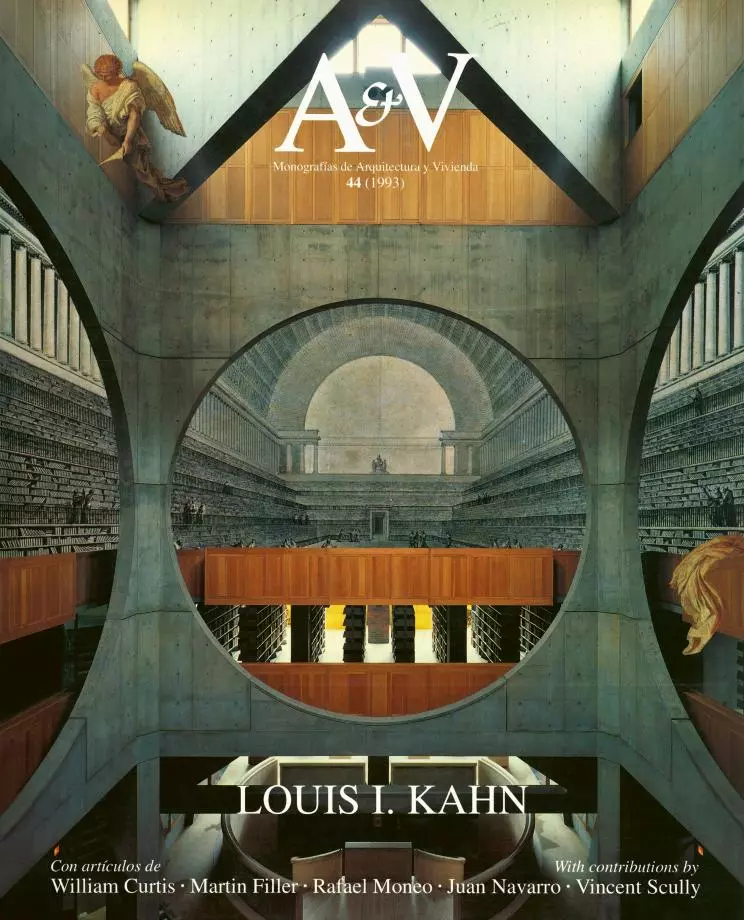Geometry as Unique Abode

Following a fruitful Sabbatical year at the American Academy in Rome, driven by the same spirit which had inspired David, that outstanding member of his stock, Louis Kahn, an obscure professor of architecture, decided in the early fifties to hurl himself into the arena and wrestle with a triumphant, omnipresent Goliath: the architecture in use at that time. It was a quest for an alternative that would not ignore the values of the architecture he so enjoyed in the Eternal City.
His weapon was the Word. Without it there was no sense in building. It was necessary to go back to giving names to what was built. A house. A school. A museum. And, in the final analysis, a city. Clinging to the task of establishing a language befitting what had been the scientific and industrial development of the first half of the 20th century, architecture seemed to have forgotten what until then had been its very attributes and obligations. Kahn resolved to address the latter and recuperate the former. In order to build, one had to know what to build. Building was not just a matter of knowing how. “Form is ‘what’. Design is ‘how’.” And naturally, ‘what’ precedes ‘how’. Yet the intuition of ‘what’ does not necessarily lead to understanding ‘how’. One must explore how form materializes. Order rests in the very origin of form, which comes to the surface and materializes, ultimately becoming the built object, or architecture. The mission of the architect is to define such order, thereby giving life to the spaces that reflect its nature, eventually making them “what they want to be.”
The continued validity of Platonism was to reveal itself once again. If to this day his words possess the inexorable force of poetry, no one should be surprised at the impact they had when they began to be disseminated through the early issues of Perspecta, the magazine published by the Yale School of Architecture, where Kahn was then teaching, at a time when architecture was so totally divorced from anything not strictly involving the representation of function. His words held the promise of an architecture different from that which was then being done, and they soon conquered students in schools as well as practicing professionals.
But Kahn’s suggestive ideas were not to stay within the confines o f a mere academic project. In twenty frenetic years of professional practice - f rom the early fifties to March 17, 1974, when he died in New York’s Penn Station, one of the public spaces that had fascinated him so much - Louis Kahn was able to show the full extent of his proposals through his built work. Houses, factories, churches, laboratories, museums, convents, university halls, memorials, national assemblies, schools, theaters, fairgrounds, auditoriums, etc. If we delve into the city of Kahn - dispersed throughout the world, as in some new version of civitas Dei - it is not difficult to ascertain, exactly as Kahn announced in those initial texts, that in the city order prevails, and that in the final analysis order is what determines form. But who imposes order? The answer is clear: order is dictated by geometry.
The world of Kahnian architecture is full of polygons and polyhedrons that define the enclosures and spaces it rests on. Order is the reflection of an intrinsic force that interrelates them. Sometimes this order allows for a regularly-shaped plan, as in the project for the Jewish community of Trenton, New Jersey, the Olivetti/Underwood factory of Harrison, Pennsylvania, the Salk Institute of La Jolla, California, or the Kimbell Museum of Fort Worth, Texas. At other times, order is manifested through interlockings and continuous chains which allow for profound formal changes, as in the project for the City Tower of Philadelphia, the Richards Laboratories at the University of Pennsylvania, the residence hall at Bryn Mawr College, or the public buildings in Bangladesh. Only in rare cases like the Dominican convent of Media or the Norman Fisher house in Philadelphia is order not a mere reflection of regularity and continuity, thereby anticipating the aleatory groupings of the eighties.
Although the continued validity of geometry and his buildings’ explicit acceptance of their monumental condition can cause Kahn’s architecture to be seen as being close to classical tradition, neither classical architecture’s preference for layout as matrix of composition nor its respect for existing typologies appear frequently in his work. Kahn’s talent stems precisely from his capacity of make us forget its presence. His greatest success as an architect lies in the fact that the tyranny of geometry is not outrightly evident in his work. In my opinion, this is due to the careful manipulation of light and his extraordinary sensitivity in the use of materials.
Light is vital to an understanding of Louis Kahn’s architecture. Light reveals architecture. It could even be said that he built structures with light, at least in a visual sense. The series of voids and overlapping polyhedrons that Kahn used to build his architecture become animated beings when lit. The framework-shells he constructed his buildings with become light-reflecting screens, and the inspired effect produces that strange feeling we sometimes have when we find ourselves within a Kahnian space. Kahn was well aware of this and it is not hard to find in his writings statements such as “the solid volume is a source of light” or “the structure provides light to the interior space.” Light is something inherent to the building, a manifestation of its reality, diverse but not different. Structure and light are representations of the same reality, architecture, with the result that Kahn’s constructions ignore the real source of light, never letting us come into contact with it.
But we must - albeit briefly - acknowledge the delicacy with which different materials f it together in his work. Kahn taught us how to appreciate the nature, the tangible reality of a material when placed beside another. Well aware of the neutrality of polished concrete, he juxtaposed it with travertine or oak and thus highlighted their textures. In the hands of Kahn, steel was transformed. And stone. And glass. And brick. These materials made it possible for Kahn to soften the presence of geometry in his work and express a sensuality that is rarely acknowledged him. Kahn’s pleasure on hitting on the very nature of his materials is what brings us in direct contact with them, an experience that turns into a true discovery and which, without a doubt, is one of the great attractions of his work.
What remains today of his lifework, of what it meant, of the impact of his beautiful words, is but a distant echo - history, but nonetheless necessary to an understanding of the more recent past. Yet the years have not diminished the interest stirred by his work, a work which, like every fine architecture, vindicates direct experience: and this is when the true dimension of Kahn the architect comes forward, when his greatness is revealed without further need for justification.






